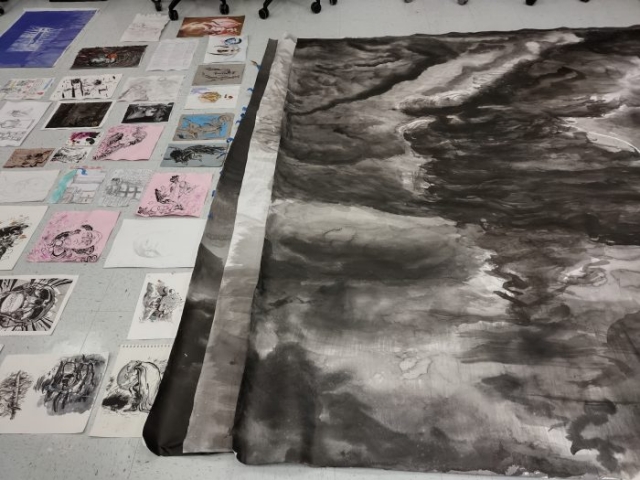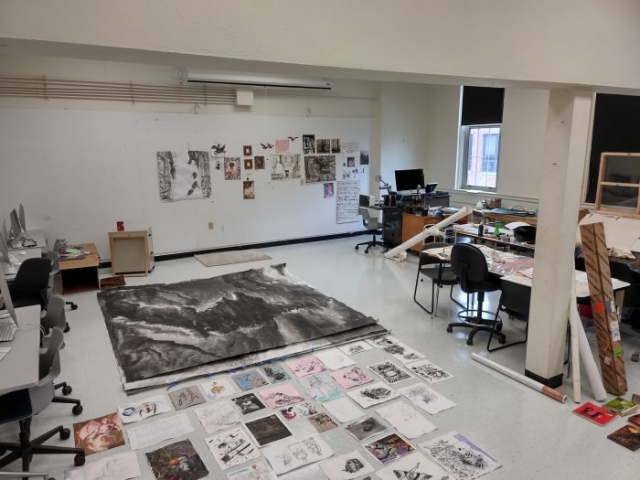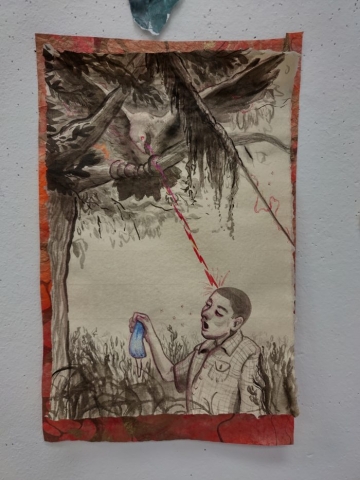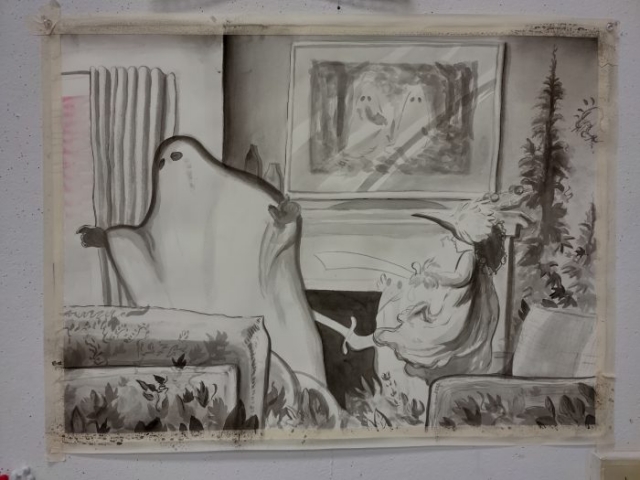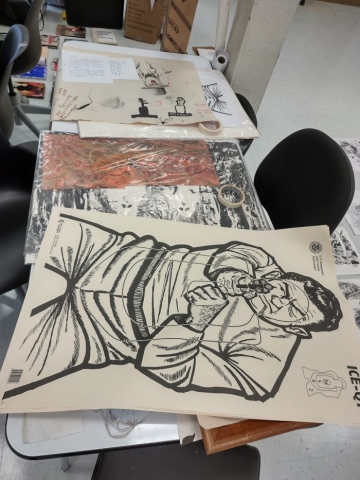
B20: Wiregrass Biennial showcases the region’s most talented contemporary artists, illustrating the South’s rich cultural heritage. The juried exhibition encourages innovative and progressive work that utilizes a variety of art forms and media and will feature paintings, sculptures as well as mixed media, new media and installation art. This year’s show features thirty-nine artists from eleven states.
B20 Artist Interview with Jonathan Adams
B20: Wiregrass Biennial is a juried exhibition that encourages innovative and progressive work and showcases the South’s most talented contemporary artists, illustrating the region’s rich cultural heritage. Selected work utilizes a variety of art forms and media, including paintings, sculptures, mixed media, new media, and installation art. Three jurors chose from a field of over 130 entries for this year’s exhibition — the first virtual exhibition ever for WMA — featuring 39 artists from 11 states.
We’ll be sharing a series of interviews with B20 artists during the run of the exhibition, and our tenth is from Bristol, Virginia -based artist, Jonathan Adams.
Where do you find inspiration for your artistic practice?
My daily life. Maybe it’s my love of food but the best way I explain my practice, is looking for sandwiches or multiplicities. When I view media, popular culture, or events, I tend to pair them with history and my biography. Finding similar events that mirror a contemporary endeavor or finding something within the context of a story, either storytelling, comics or any storied medium. Daily life and my practice I feel are one and the same.
How does living and working in the South impact your work?
Before I left the south I didn’t think much actually. However, I understand the South has a unique way of conversing with time. It represents the past and the present. The South tends to travel with me, it is home, it is spiritual and mystic. But it is also more than me, grand and terrifying; The American South is sublime.
But on a less poetic note, there’s not a centralized art world in the south. It is everywhere and spread out. It visually and historical informs my work but I tend to travel a ton for my practice, for exhibitions and residences. Also, the south is quiet. You can live comfortably, stretch your life to breath from the day-to-day busyness that is the city. I get to see a lot of the word this way.
Your artist statement mentions the language of graphic novels. Are there any that you go back to frequently?
Oh, my goodness yes haha. I reread Takehiko Inoue’s Vagabond often. His brush strokes are gorgeous and some of the topics of nomadism, living off the land and liminal spaces speak to today’s social climate. Alan Moore’s run on Miracleman that reflected a postmodern conversation with shifting British politics and begins to feel like the beginnings of The Watchmen. The Bunker drawn by Joe Infurnari and anything by the artist Francisco Francavilla.
What role does the use of color play in your work? Is this inspired by graphic novels, as well?
That’s a good question! It’s from contemporary and past comics / cartooning / narrative tableaus / studies. The greys/blacks relate to traditional comics and manga. Will Eisner’s The Spirit and Osama Tezuka’s Blackjack are some aesthetics I lean to. However, I also liken the color choices from works from Old Masters like Giovanni Tiepolo, Paulo Veronese, Honoré Daumier and Gustave Doré. Furthermore, I think about placing black bodies into art historical canon and I do not denigrate the artists that are doing that.
However, I enjoy the idea of creating a work that mimics the history of an object. Why not make an object that breathes what it will become, history? Finally, I use color as an interjection of magic, southern mysticism onto our plane of existence. Browns and grays take precedent and echo older works however overly saturated hot colors not only push the flatness of a graphic medium but also disrupt the eye.
Could you talk about I Want to be Better; Please show me how, your piece featured in B20: Wiregrass Biennial? Could you describe what is happening in the work, and why you chose to use the colors you did for this piece?
Upon arriving home last year, I began to look through albums of my family with my grandmother. She began to show me photos of our extended family being baptized in Mt. Airy, NC. My curiosity peaks at this moment, because I feel photos are snap shots of culture that are meant to be shared. Baptisms always feel southern even within the context of a larger or metropolitan church. They happen in rivers, lakes or in this case in a basement floor. It’s like Salvation can occur anywhere, and a higher power is everywhere. I remove God’s grace from the water and place my fictive lightening from the horrors of the colonizing thunderbirds that has been gathered and stored.
I was baptized around 13-15 and I felt this sort of energy. I believed that once I exited the water, I would be saved. It would deliver my family and friends unto new grounds. It would give me the strength to scale any mountain and forge any path. I left feeling better and of course I do not denigrate religion, its effects on the world or its followers; I have a healthy skepticism for any power structure.
I thought about the many people who have or had nothing. I thought of their options, the lengths a person would go through to find the true path in life. What would you do if you were offered everything? Eternity. Love. Understanding. Knowledge. Everything. I was seeing my family give themselves to something else. Baptisms offer salvation in the water, but what if the power was not what it seemed? I began to stage the scene in my apocryphal Appalachia. It’s a fictive Appalachia where it is ravaged by the intrusion of a spiteful Earth, littered with myth, excavated history, phantasms and invaded by Thunderbirds from another home. These birds begin to represent colonization, racism power, appropriation, resplendence, fascism and the list continues. They want. They take. They say they are our friends.
I thought of a church to them, in a place where the kudzu assimilates, and the people look for a new hope. Where people submerge themselves in the lightening in hopes to find a way out of there fraught environment. How long would they wait? Which one believes in destroying an identity to conform to a world they may not need? Which ones are reluctant and lament the loss of another individual to the birdsong, the lightening? Within the image I sought for the centrality of the pool with addition of the highly saturated red to appear violent, mystic, pulsing and coursing with a history of infection and claiming. This color is an interjection to our gray and black world. It is not from here. It is spreading alien roots. I wanted to show this magic front and center. Then show how bodies interact and live with it.
Your work deals with themes of exploring personal identity and individual narrative, while taking on larger themes of social change and examining long-established power structures in the South. How are recent events, particularly the BLM movement, informing the work you are creating now?
In every way possible. There seems to be a tendency to create a reaction for every news headline or event, however I don’t believe a singular person or group will be able to keep up. This reminds me that socio-political change takes time and can come from any form. There is no right way to protest or critique, there is only the statement within the action. Recently the movement makes me re-evaluate my work.
What forms can my work take, how do I show a life in living while acknowledging the time we reside? But also, I live my life differently now. I’m at home more, so I make drawings on my couch, while watching tv, they’ve become intimate and vulnerable. Which is exactly what we need right now.
It’s tough to have these conversations especially when the worth of an image is being devalued when during this time it should take precedent. However, I want to keep my work biting but create a slow read within the work. I want to change your opinion. I want to create empathy. I want the person who disagrees with my work to enjoy the image but for it to move them, question their bias and for the person to ask, “Why does this image bother me?” Almost as if to infiltrate their headspace.
I have been taking time. Observing. Engaging when a voice is needed. I won’t keep up. But through slow rigorous questioning, careful, deliberate planning is the one way we all can find the correct course to take.
Are there any artists in particular making work in response to the current social climate who are inspiring to you right now?
I’m inspired by every artist out there working right now, it’s such a wild climate to work through; I have such a mad respect for them all. To put names down, I’ve been into Mark Thomas Gibson and the new Run the Jewels album for starters. Mark always puts out work and draws like crazy and the Jewels just found the perfect time to release an album about class and social discourse. It’s been fueling my studio days!
Furthermore, some other badass artists are Chau Nguyen whose an amazing painter and good friend working in Philadelphia. Her works are fuzzy, layered, about memory, collective histories and identity. She puts in daily work, despite the climate. Chau shows that you can still have a practice and push through. Nuveen Barwari is a multidisciplinary artist based in TN at residence at CO-OP Gallery at the time of this interview. She has a brilliant way of combining textiles with a plethora of material and is always on the front lives of advocacy. She speaks about new cultural identities, especially the clashing of cultures; this is a paramount conversation today!
Sidebar, I believe life and art are the same. You don’t need to produce even though we all have heard from someone that this is the time for it. Rest is a form of protest, staying inside, wearing a mask, advocacy is an art form. I’m also inspired by the people who understand that self-care is important. You can’t defund, protest, speak-up, create or restructure society without finding time for yourself to simply live.
Is there anything new you are working on that you’d like to share with us?
Haha yea I have been making drawings in all of this. I find my process is slower and requires time more so than it ever has. I’ve been thinking of screens as portals into worlds outside the home. I’ve been creating drawings from film stills and runs/hikes I take in the wilderness. Recently, running for Arbery (Before Floyd) is a piece that speaks on a topic that has faded already. When Ahmaud Arbery was gunned down in February, sometime in May when people began running in memory for justice of his killers. However, this was right before George Floyd who arguably started the “Enough is enough” feeling to the protests that have occurred. This was a strange time because people were only believing this was it. This wouldn’t get any worse, there’s no way this could happen again. But it did.
Breonna Taylor who still seeks justice from her killers at the time of this interview seems to also receive glossing over. History tells us pandemics highlight flaws in economies and during this digital age everything is transmitted until you’re fatigued. You see another shooting, fight, arrest, this person said some shady shit and now you look for justice. Flurries, barrages of information throw us into the next scenario until the construction of our lives diminishes and only the despair is left.
I remember running for Arbery, thinking this could help. When Floyd was murdered, I felt insignificant. The movement never stops. Hatred, bigotry is always looming, and we must always work to keep it at bay. Within the image, the viewer as the nomad has come upon a scene. A dilapidated car (A stand in for a body) with no movement with red bolts slowly infecting the ground and a hidden phantasm. Looming. Waiting. Biding its time to strike. Everyday, wherever we go, we must be safe. We must be ready. We must push forward and meet the problem head on.

